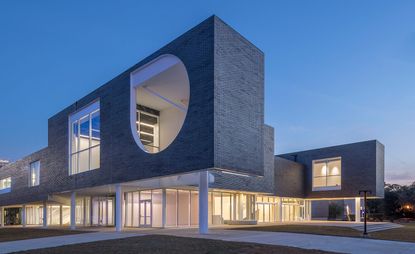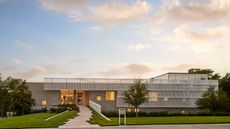Michael Maltzan lightens the mood in Houston with his first brick project

If you are an amply endowed institution of higher education in need of a striking new building for a particular function or department, there are plenty of architects who are up to the task. But if it’s that elusive bridging of disparate fields, seeding collaboration and fostering connection you’re after? Call on Michael Maltzan. Rice University did just that a few years ago, and now its leafy campus in Houston, Texas is home to the Maltzan-designed Moody Center for the Arts: a dynamic container for creation, experimentation, and presentation.
‘We’re a different kind of a space,’ says Alison Weaver, executive director of the Moody (named for the Texas-based foundation that provided most of its $30 million cost), which opened to the public last week. ‘We’re not a typical museum. We’re not a typical campus building or classroom building. We’re really trying to do something new here – something innovative and somewhat radical in its approach.’
Encompassing exhibition spaces, classrooms, a 150-seat black box theatre, a maker lab (wood shop, metal shop, paint booth, rapid prototyping wizardry), and a café, the 52,465 sq ft Moody Center is remarkable in its range, but Maltzan’s design doesn’t merely corral multiple programs under one skylight-punctuated roof. Instead, it seizes upon the elasticity of architecture to integrate adjacent and simultaneous activities, connecting them to one another, the Rice campus, and the world beyond its tree-lined quads.

The vertical gallery and seating area
‘One of the primary tools that we’ve used in the architecture is real transparency and openness,’ says Los Angeles-based Maltzan, pointing to the two-storey building’s expansive sight lines, abundant floor-to-ceiling windows, and multiple entrances bracketed by ‘starburst’ columns positioned to align with existing pathways around the campus. ‘That transparency from outside to in and also from inside to outside makes this building a true beehive of activity – almost a microcosm, like a small village or city.’
Invigorated rather than intimidated by complexity, Maltzan is a master collapser – of discrete territories and disciplines, of building and landscape, of architecture and urban design. The Moody reveals Maltzan’s equally formidable skills as a choreographer. To pass through the building is to encounter a myriad of spaces and scales ranging from intimate (an office, an audio-visual editing suite) to communal (a soaring double-height central studio crowned by a graphic constellation of LED lighting), all interwoven by strategically placed apertures, overlooks, and fissures that create opportunities for chance encounters and discovery.
With a dusky exterior that contrasts with its luminous white insides (purists will pine for monochromatic furnishings, but students seem to be enjoying the plush, blobby neon seating that colonises most interstitial areas), the Moody is Maltzan’s first brick building – a project requirement for material continuity across campus. He chose Manganese Ironspot brick for its chameleon-like qualities.

The facade is made of Manganese Ironspot brick
Depending upon the weather and time of the day, the dark exterior can take on a blueish glow, a silvery gleam, or a deep purple haze. ‘It changes your perception of traditional brick, and the way it’s been made – its thinness and lightness, as opposed to heavy, massive brick – relates to the variability of life around it,’ explains Maltzan. ‘I think that idea, of a building that is not heavy and not weighted down, but that is light and variable and dynamic, is for me the main metaphor of what is meant to happen at the Moody Center.’
The ambitious opening programming includes a workshop developed by Olafur Eliasson and a mesmerising extraterrestrial video installation by Diana Thater, as well as a residency by visiting artist Mona Hatoum. The Moody’s main gallery space debuts with an exhibition of 25 photographs by Thomas Struth, including a massive 2007 image of an oil rig at the DSME shipyard on South Korea’s Geoje Island. Restrained by a web of tethers that slice the composition into extruded triangles, the semi-submersible drilling rig comes alive.
‘Before I saw this, I never thought that I would want to photograph an oil rig,’ admitted Struth, who was on hand for the opening festivities. ‘But in this situation it was like Gulliver — the giant in chains — and you somehow get a much better understanding of what kind of energy is embedded in this structure.’ The scene, with its pulsing readiness and celebration of complexity, feels right at home in the Moody. ‘“Institution” doesn’t seem to be the right word for it,’ notes Struth, glancing around the sky-lit, double-height gallery. ‘It’s a centre – a centre of crossings.’

Entrances are bracketed by ‘starburst’ columns

Installation view of the inaugurating exhibition, Thomas Struth’s ‘Nature & Politics’

The centre houses gallery, performance, and event spaces...

...along with classrooms, a 150-seat black box theatre, and a maker lab

The Lovett Lounge on the second floor of the building
INFORMATION
For more information, visit the Moody Center for the Arts website and the Michael Maltzan Architecture website
ADDRESS
Moody Center for the Arts
Rice University
6100 Main Street
Houston, TX 77005
Wallpaper* Newsletter
Receive our daily digest of inspiration, escapism and design stories from around the world direct to your inbox.
Stephanie Murg is a writer and editor based in New York who has contributed to Wallpaper* since 2011. She is the co-author of Pradasphere (Abrams Books), and her writing about art, architecture, and other forms of material culture has also appeared in publications such as Flash Art, ARTnews, Vogue Italia, Smithsonian, Metropolis, and The Architect’s Newspaper. A graduate of Harvard, Stephanie has lectured on the history of art and design at institutions including New York’s School of Visual Arts and the Institute of Contemporary Art in Boston.
-
 Love, melancholy and domesticity: Anna Calleja is a painter to watch
Love, melancholy and domesticity: Anna Calleja is a painter to watchAnna Calleja explores everyday themes in her exhibition, ‘One Fine Day in the Middle of the Night’, at Sim Smith, London
By Emily Steer Published
-
 Two new books examine the art of the logo, from corporate coherence to rock excess
Two new books examine the art of the logo, from corporate coherence to rock excessPentagram’s new book reveals 1,000 brand marks, while the art of the band logo is laid bare in Logo Rhythm
By Jonathan Bell Published
-
 Art, culture, watches & jewellery editor Hannah Silver’s gift guide
Art, culture, watches & jewellery editor Hannah Silver’s gift guideFrom a Beryl Cook cushion to an offbeat diamond ring, there's something for everyone on this Wallpaper* editor's gift guide, embracing art, culture and style
By Hannah Silver Published
-
 Step inside a Brooklyn Brownstone that bridges old and new
Step inside a Brooklyn Brownstone that bridges old and new'Brooklyn Brownstone' has been refreshed by Jon Powell Architects (JPA) and the result is a contemporary design rooted in modern elegance
By Ellie Stathaki Published
-
 The new Frederic Church Center at Olana complements its leafy Upstate New York site
The new Frederic Church Center at Olana complements its leafy Upstate New York siteTour the Frederic Church Center for Art and Landscape, now open at Olana, a historic site in Upstate New York, courtesy of architecture studio ARO
By Ellie Stathaki Published
-
 On a sloped Los Angeles site, a cascade of green 'boxes' offers inside outside living
On a sloped Los Angeles site, a cascade of green 'boxes' offers inside outside livingUnStack, a house by FreelandBuck, is a cascading series of bright green volumes, with mountain views
By Ellie Stathaki Published
-
 This New York brownstone was transformed through the power of a single, clever move
This New York brownstone was transformed through the power of a single, clever moveVoid House, a New York brownstone reimagined by architecture studio Light and Air, is an interior transformed through the power of one smart move
By Ellie Stathaki Published
-
 A new Texas house transforms a sloping plot into a multi-layered family home
A new Texas house transforms a sloping plot into a multi-layered family homeThe Griggs Residence is a Texas house that shields its interior world and spacious terraces with a stone and steel façade
By Jonathan Bell Published
-
 Light, nature and modernist architecture: welcome to the reimagined Longwood Gardens
Light, nature and modernist architecture: welcome to the reimagined Longwood GardensLongwood Gardens and its modernist Roberto Burle Marx-designed greenhouse get a makeover by Weiss/Manfredi and Reed Hildebrand in the US
By Ian Volner Published
-
 A bridge in Buffalo heralds a new era for the city's LaSalle Park
A bridge in Buffalo heralds a new era for the city's LaSalle ParkA new Buffalo bridge offers pedestrian access over busy traffic for the local community, courtesy of schlaich bergermann partner
By Amy Serafin Published
-
 Tour this Bel Vista house by Albert Frey, restored to its former glory in Palm Springs
Tour this Bel Vista house by Albert Frey, restored to its former glory in Palm SpringsAn Albert Frey Bel Vista house has been restored and praised for its revival - just in time for the 2025 Palm Springs Modernism Week Preview
By Hadani Ditmars Published